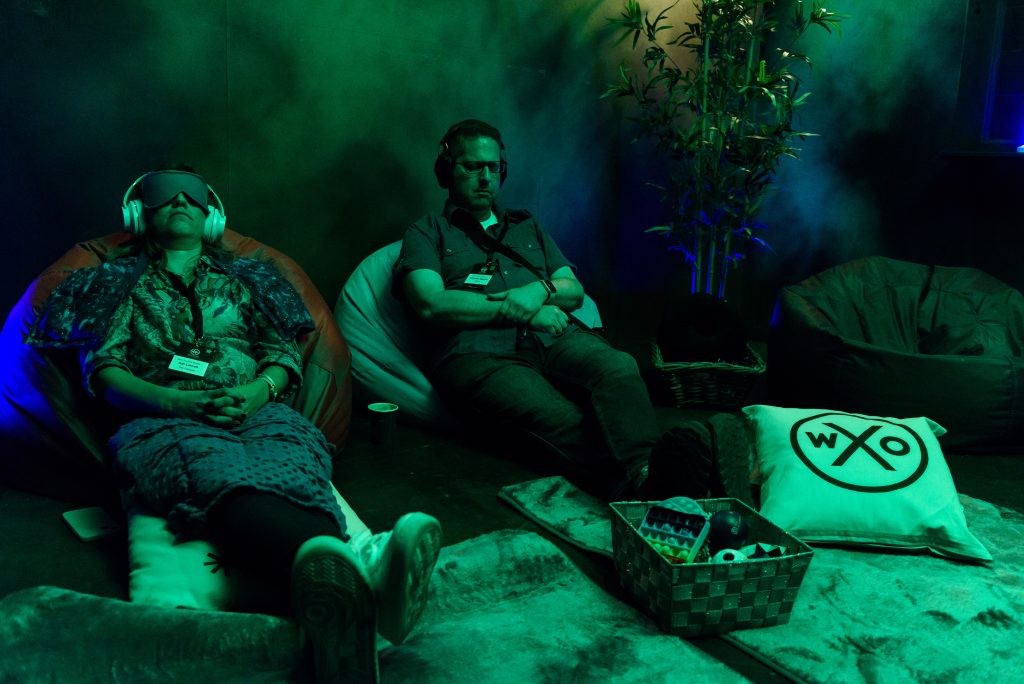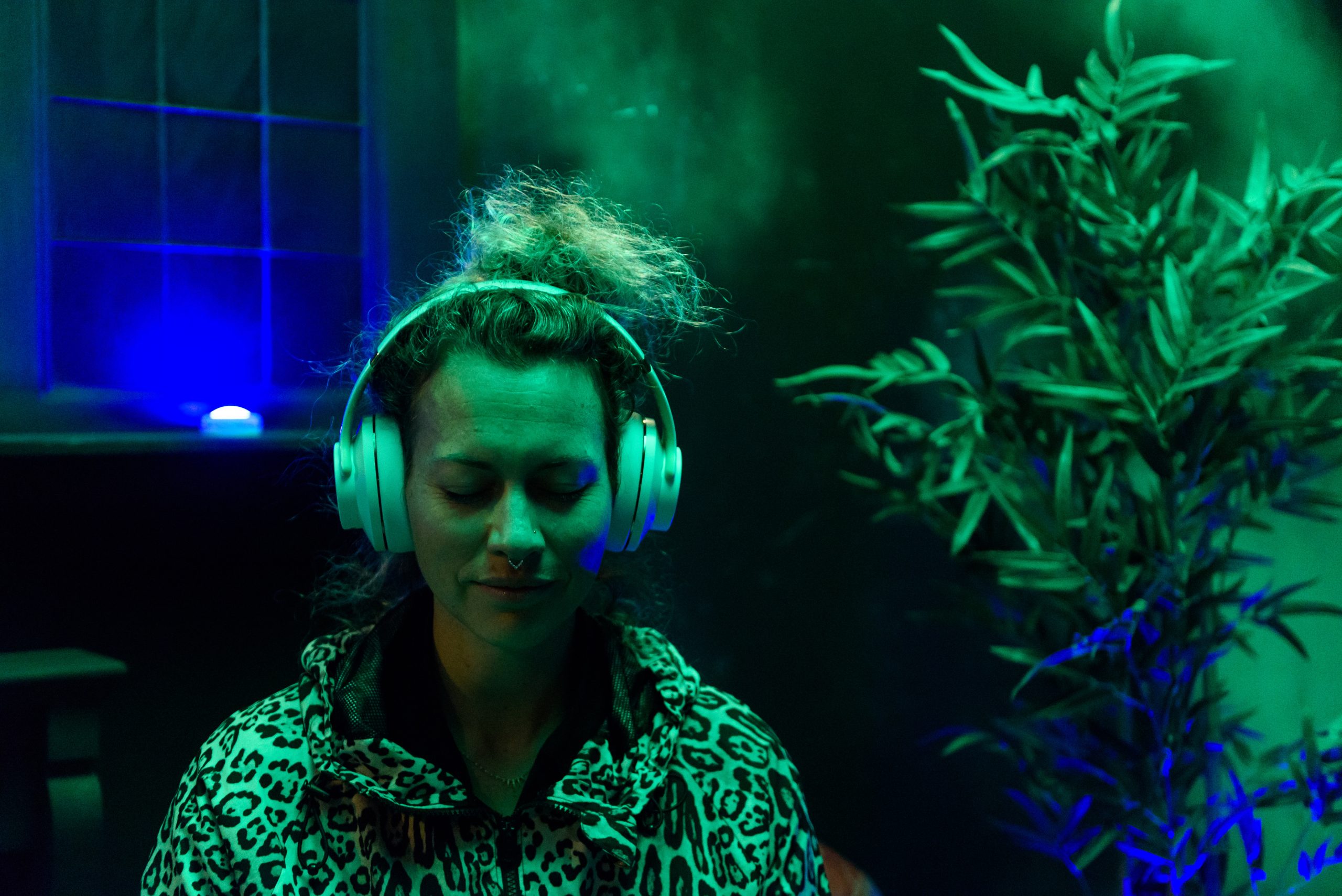There is an invisible space around each and every one of us. It’s what separates us from other people, and is what we commonly refer to as our personal space.
When we are well regulated, we feel safe and able to occupy space, and therefore connect to others. When we are not, we unconsciously seek to find psychological safety and use avoidance responses. When we think about the sensory aspects of event design, it’s easy to consider noise/sound, lights, food, smells, and so on – but touch and invisible/personal space can be trickier.
Helen Moon, Chief Executive and Founder at Eventwell – and creator of the Quiet Room at this year’s World Experience Summit – covers three important aspects behind the idea of invisible and personal space:
- Why it’s so important from a physiological and psychological perspective for all of us to have a safe space to regulate and decompress
- The 4 types of personal space and why they matter
- The very real difference it can make to the experiences we actively seek
You’ll also learn about aspects such as gender and culture, and how invisible space can impact not only the neurodivergent, neurotypical participants too.
We Are All Neurodiverse
Neuroinclusion refers to all of us, because we are all neurodiverse. The human race is made up of a mixture of different brain types and neuro types and wiring. We’re all individuals, and we’re all wired differently. When we talk about a spectrum, it’s not just an autistic spectrum. There’s a spectrum for ADHD. There’s a spectrum for neurotypical people. There’s a spectrum for people who are introverted, and for people who are extroverted. We all exist on some kind of spectrum.
There’s also the mental health continuum, which we all move up and down within depending on things that we have going on in our lives, things that are happening around us, things that are happening personally, and things that are happening professionally. Our mental housing encompasses all kinds of different areas of our life. Then there’s also a physical health continuum. So there are lots of spectrums and continuances in terms of how we all exist and function throughout our day to day.
What Is Invisible Space?

There is invisible space around each of us. We normally refer to this space as our personal space. It’s also referred to in social psychology as interpersonal space. We all have it. It’s what separates us from other people. It’s what connects us to other people. But do we truly understand it, appreciate it and have respect for it in events and experience design, when we’re trying to fit as many people as possible into a space?
Everybody talks about their own personal space. And certainly at the moment, it seems like we all can’t get enough of it, whether that is digital personal space in our 24-7, interconnected online world, or real-world personal space. Understanding why we need personal space and how we can regulate it can really help all of us to live a more balanced life.
The Downstairs And Upstairs Brains
Personal space is about protecting, reducing stress, and focus. It can be broken down into a series of invisible bubbles that radiate from us. These are all deep within our primitive or Ithilien brain, or what’s fondly referred to sometimes as the “downstairs brain”. This is the instinctive area of the brain, and is very well developed from birth. It’s responsible for our basic functioning: our breathing, blinking, heart beating, sleeping, digesting, and all of those homeostatic functions within the body that just happen automatically.
Within the downstairs brain we’ve got our brain stem, the limbic region, and the amygdala. This area of the brain is responsible for big emotions like anxiety and anger. It’s one of the oldest parts of our brain, and it’s also responsible for our survival. So this part of the brain activates the fight, flight or freeze reaction, or what we call a stress response. Its real name is the sympathetic nervous system, which is part of the autonomic nervous system.
This downstairs part of our brain is our reactive brain. When this part of our brain is glowing red because the stress response has been triggered, or the sympathetic nervous system is in play, we tend to react very emotionally rather than respond. That’s because the upstairs brain, which is our prefrontal cortex, is that part that’s responsible for our executive functioning: paying attention, thinking, planning, controlling our impulses, and problem solving. So when we’re designing events and experiences, that’s the part of the brain that we need to be trying to design things towards.
This part of the brain doesn’t reach maturity until our mid 20s – so if we expect adolescents and young adults to act like adults, their brain isn’t fully developed enough yet to enable them to do that, which is why we still get very emotional reactions from them. This “upstairs brain” is the receptive area of the brain, and we need to be in a balanced state for it to work to its full potential.
When we experience stress, anxiety, or any kind of difficult emotion, our upstairs and downstairs brains become less connected. This is because the survival instinct, stress response, and sympathetic nervous system in our downstairs brain has been triggered, which will start to close down areas of our psychological and physiological makeup that it deems to be non-essential. We go into survival mode. The world has changed massively from when this survival instinct was designed. We haven’t evolved yet enough as human beings to cope with the modern world, so we still have a stress response intuitively built within us that is designed for the old world.
It can be difficult when we’re stressed, anxious and nervous to pay attention to experience and engage with others. In other words, we’re going to start being reactive rather than taking time to respond. And we all behave and react very differently. We’re all individuals. We’re not robots, we’re not sheep.
Think about your own mind when you’re stressed: can you think clearly? Do you think you make good choices? How do you communicate with others? What does your stress response normally pull you towards – do you fight or run away? For a lot of neurodivergent people, their go-to stress response will be to run away and hide. From a neurodivergent perspective, overload or overwhelm equates to mental distress. The brain needs to regulate itself: it needs to decompress, return to balance and homeostasis.
The 4 Types Of Personal Space

Proxemics is the study of space in human social interactions. In the book The Hidden Dimension, the anthropologist Edward Hall illustrates four different types of personal space, which are based on social, emotional, and physical factors.
- Intimate Space: space extending outward from our bodies of about 18-20 inches in every direction. This is reserved for partners, families, pets, and our closest friends. It’s not a space for strangers, particularly for those who are neurodivergent.
- Personal Space: approximately 1 to 4 feet around us. Friends and acquaintances can comfortable occupy this space, especially during conversation, but strangers are forbidden.
- Social Space: from about 4-12 feet around us. This is where we generally feel comfortable conducting routine social interactions with new acquaintances or strangers. It’s a space that does not not feel intimate, and is ideal for situations that require formality.
- Public Space: a bubble or layer that’s open to everyone, ranging from about 12-25 feet. This is used to engage with larger audiences – if you speak on a stage, for example, so you’re able to establish authority and control.
You will always be aware of new people that enter your space, because your amygdala is constantly monitoring all of these four spaces. The amygdala controls that stress response in the sympathetic nervous system, and is also involved in fear. So it’s very important to be aware of when we’re designing spaces.
We begin to develop our individual sense of personal space around the age of 4-5. The size of our bubbles will usually cement themselves by this time we reach adolescence, but different cultures and genders will have different views on this. The idea of personal space for a woman would look very different to a man, and also to the female assigned at birth and the male assigned at birth.
The Factors That Affect Your Own Personal Space
Most of us are unconsciously aware of our own personal space, but probably don’t pay much attention to it until we’re in a situation that makes us feel uncomfortable where we want to retreat. When our interpersonal boundaries are infringed upon in social situations, it can feel invasive, so we’re likely to experience physical or emotional discomfort. You may not necessarily be fully aware of it as a lot of the time, it’s instinctual. But you may find that you’ll automatically move your body away to reinstate comfortable proximity and reinstate control.
Personal space is subjective. What feels too close for comfort for you might be acceptable for somebody else. But it’s having that awareness of the differences that mean it’s going to look very different, for example:
- Neurodivergent compared to neurotypical people
- Introverted compared to more extroverted
- Cultural differences such as different religions, different areas of the world, childhood and upbringing
- Individual personality traits, age, gender, and different attitudes and social beliefs
- Neurodevelopmental differences such as autism, ADHD, bipolar, OCD, stress disorders, general anxiety disorders, or a history of abuse
As experience designers, you’re never going to know an individual’s personal boundaries. But by having awareness of this when we’re starting to design our experiences, and then starting to plan for safe spaces that someone can retreat to for safety if necessary, we can help to mitigate them.
Why Do We Need Our Space?

There are three models that determine this: the overload model, the stress theory, the communication channel.
- The Overload Model. This is the most important model to consider for neuroinclusion, and has to do with information overload. When others are very close to us, their voices seem louder, their perfume smells stronger, and their movements can seem startling. When you have a neurodivergent individual, they start to go into sensory overload. This leads to all kinds of different complications in terms of upstairs brain and executive functioning, as we are bombarded with sensory information which all needs to be processed cognitively. This can be draining and can eventually lead to being completely overwhelmed.
Maintaining space helps an individual to remain calm and centred. It also allows us to make good decisions, because the upstairs brain is still engaged. The overload model builds on the suggestion that we maintain personal space in order to reduce the potential overload of our sensory processing systems. - The Stress Model. Personal space invasion is related to increases in physiological stress and psychological stress. This is an important consideration to maintain personal space at events and experiences to protect people from excessive stress. The stress model says that personal space can shield us from stressful stimuli that might be present when others come too close to us. Our amygdala is central to monitoring those bubbles. It’s also central to our need and desire for space.
The primitive fear centre in our downstairs brain is there to keep us safe and to keep us alive. The closer someone is to us, the more likely it is that the amygdala and sympathetic nervous system could be triggered. When people are too close, it can result in serious consequences. If distance is maintained, you’re less likely to see aggression – it also allows us to fend off high noise levels that may animate some people. - The Communication Channel. Our personal space also communicates the nature of our relationships. Interpersonal spacing reflects the nature of the relationship between people, and also relates to other non-verbal communications such as eye contact and body orientation. By watching two people interact with each other, you can generally judge the relationship they have. Maintaining personal space can be conceptualised as controlling the type of message we want to communicate to others.
The Four Quadrants Of Psychological Safety
Psychological safety is crucial. If we don’t feel psychologically safe, we are not going to engage, interact, or participate. When we feel unsafe, it closes down our brain and we react emotionally. A lot of people shut down.
Psychological safety will look very different to each of us, but generally, there are four quadrants to psychological safety:
- Inclusion Safety
- Learner Safety
- Contributor Safety
- Challenger Safety
Each of these four stages highlights a unique human need that exists across demographics, geographics and psychographics. When we feel safe, we believe that we won’t be punished or humiliated for speaking up with ideas, questions, or concerns, or for making mistakes. The biggest part of our mental wellbeing is that ability to allow ourselves to make mistakes and not aim for perfectionism, which is damaging to our mental wellbeing and health.
When we’re experiencing mental distress and the sympathetic nervous system has been triggered, the downstairs brain is controlling our reactions and we’re less likely to be feeling psychologically safe, because the survival button has been pressed. When we’re feeling balanced and we’re in homeostasis, the parasympathetic nervous system is doing its job well. Every action has an equal and opposite reaction: the parasympathetic nervous system is the opposite to the sympathetic nervous system. It keeps our heart beating at a nice normal rate, it lowers our blood pressure, it switches the upstairs brain back on, it returns our immune and digestive systems back to normal, it controls our responses, and it helps our brain to help us restore that executive functioning.
We’re likely to be feeling and experiencing psychological safety when the parasympathetic nervous system is doing its job. Safe spaces, quiet rooms and resilient spaces all provide a safe environment for psychological safety, and for the parasympathetic nervous system to do what it needs to do. They are a room that creates personal space, allows us to balance our nervous systems, and allows our downstairs and upstairs brain to start chatting to each other again. This in turn allows us to engage, participate and respond.
The WXO Take-Out

As we learned in Beth Rypkema’s Campfire about accessibility, when we design to accommodate individuals with different needs, we often end up improving and opening up new dimensions to the experience for all participants.
By thinking about personal space early on in the design process, we can make our experiences not only more accessible for neurodivergent people, but also for neurotypical participants.
So next time you’re designing an experience, ask yourself:
- How might you design for the 4 types of personal space?
- How might you include a safe space or quiet room?
- How might you account for the different factors that affect people’s perception of personal space?
Want to come to live Campfires and join fellow expert experience creators from 39+ different countries as we lead the Experience Revolution forward? Find out more here.






